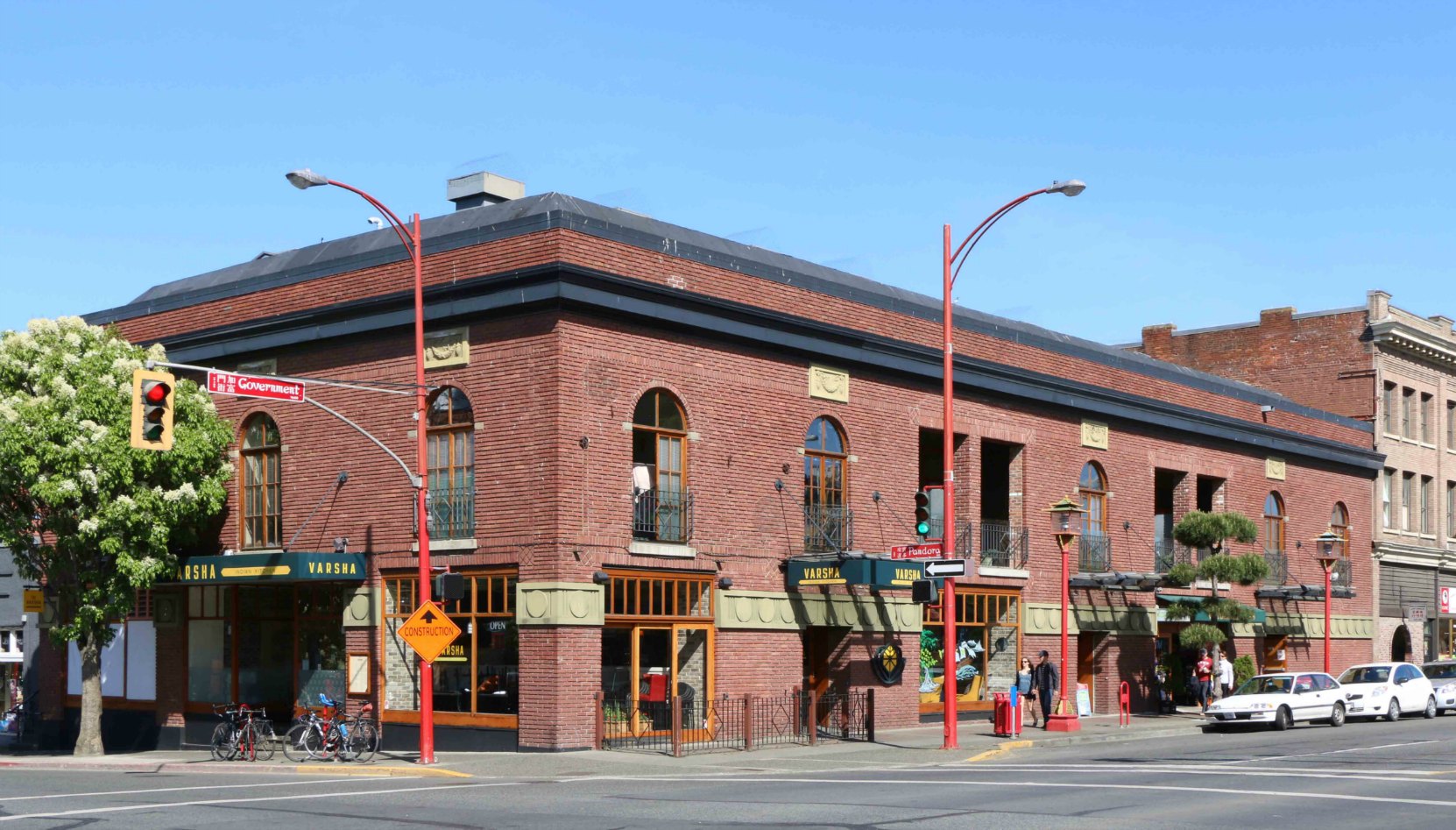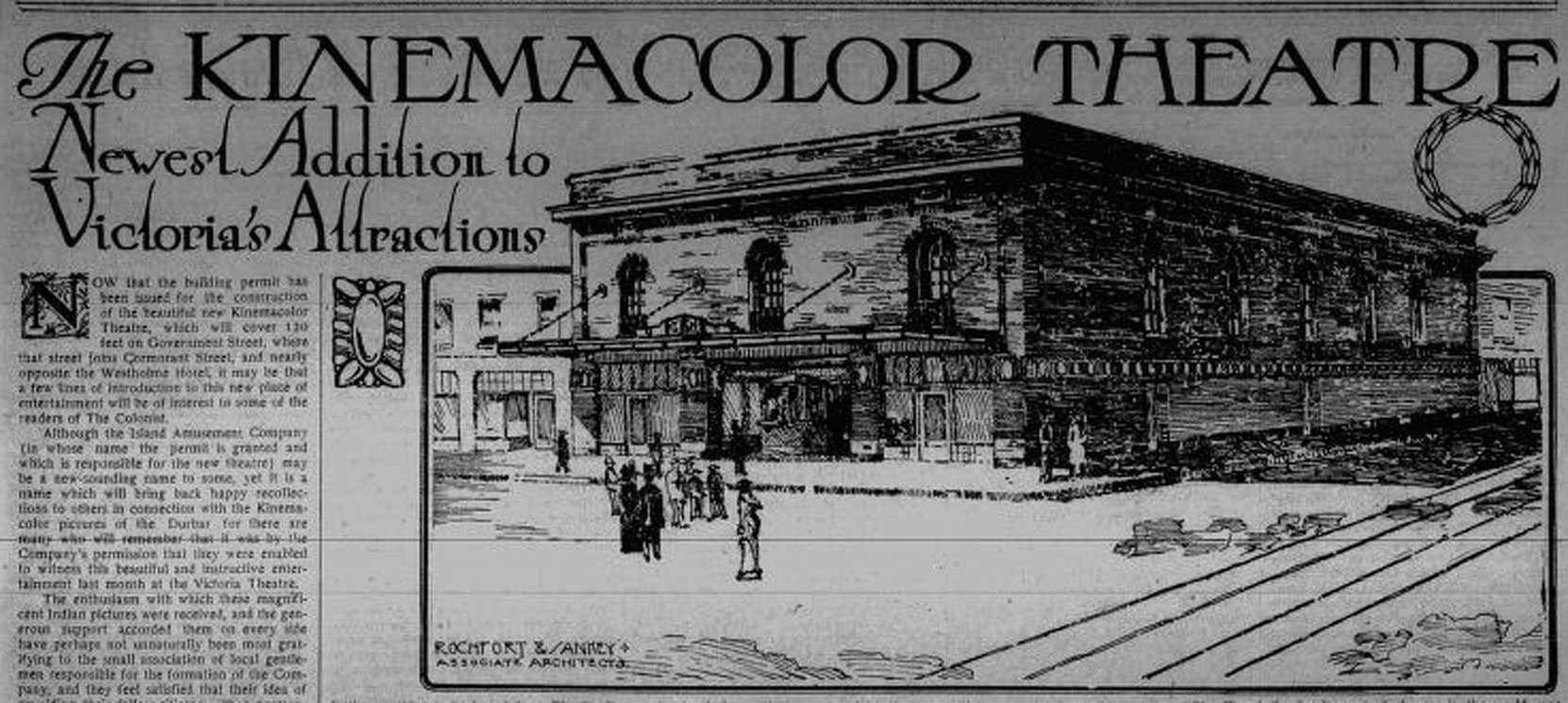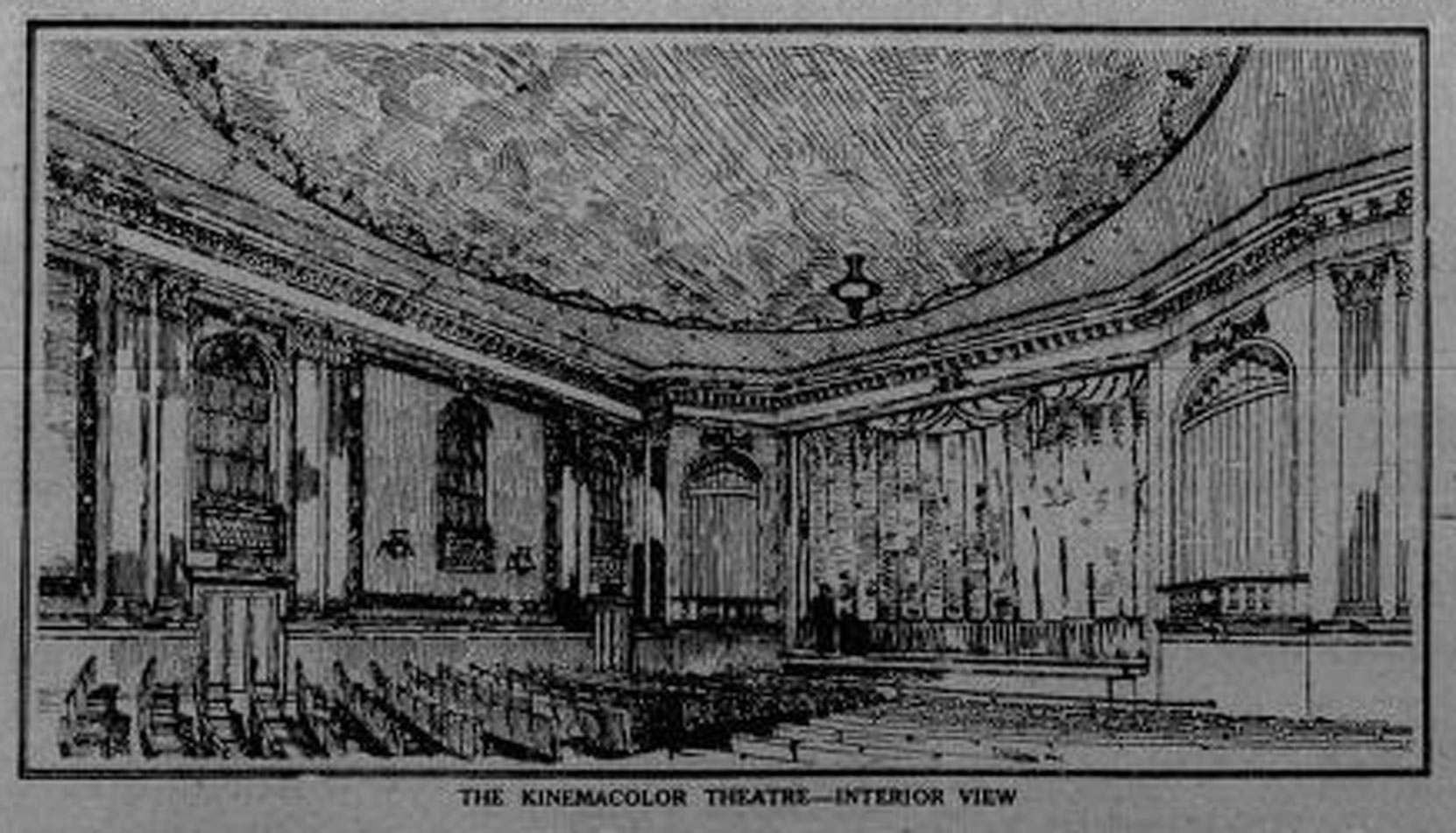Victoria History
The Origins of the Kinemacolor Theatre
1600 Government Street / 588 Pandora Street
The building at 1600 Government Street / 588 Pandora Street is now a mixed use strata commercial and residential building with two commercial strata units and eight residential condominium strata units.
But it was originally designed and built in 1913, by architects Rochfort & Sankey, for the Island Amusement Company, as the Kinemacolor Theatre.

1600 Government Street, originally built in 1913 as the Kinemacolour Theatre.
Here is some history of the Kinema Color Theatre, 1600 Government Street, taken from original sources:
First, here are two 1913 architects’ drawings of the Kinemcolor Theatre by the firm of Rochfort & Sankey.

1913 architects’ drawing by Rochfort & Sankey of the exterior of the KinemaColor Theatre, 1600 Government Street (Victoria Online Sightseeing Tours collection)

1913 architects’ drawing of the interior of the KinemaColor Theatre, 1600 Government Street (Victoria Online Sightseeing Tours collection)
Here is a 1913 article from the local newspaper about the Kinemacolor Theatre:
“The Kinemacolor Theatre
Newest Addition To Victoria’s Attractions
Now that the building permit has been issued for the construction of the beautiful new KInemacolor Theatre [note: the building permit was issued to the Island Amusement Company by the City of Victoria on 12 February 1913], which will cover 130 feet on Government Street, where that street joins Cormorant Street, and nearly opposite the Westholme Hotel, it may be that a few lines of introduction in this new place of entertainment will be of interest to some of the readers of The Colonist.
Although the Island Amusement Company (in whose name the permit is granted and which is responsible for the new theatre) may be a new sounding name to some, yet it is a name which will bring back happy recollections to others in connection with the Kinemacolor pictures of the Durbar for there many many who will remember that it was by the company’s permission that they were enable to witness this beautiful and instructive entertainment last month at the Victoria Theatre.
The enthusiasm with which these magnificent Indian pictures were received, and the generous support afforded them on every side have perhaps not unnaturally been most gratifying to the small association of local gentlemen responsible for the formation of the company and they feel satisfied that their idea of providing their fellow citizens with a permanent theatre to display all the wonderful repertoire of colored pictures of the same nature,has been to a large extent endorsed by public opinion and stood Kinemacolor, with its marvelous natural beauty and effect, the very last word in motion pictures, is something that will appeal and always will appeal especially to Victorians, in so far as they, of all peoples, enjoy to the full its beautiful gifts, which nature herself has so lavishly surrounded them.
Those, however, who witness the performance at the theatre last month will realize that a theatre to be a proper setting to these pictures must be more than a mere picture-house, it must be a real frame cut and molded to the pictures, enhancing their beauty and setting off their effect, besides being constructed so that a clear and unobstructed vision may be obtained from every one of the 700 seats within it.
Messrs. Rochefort & Sankey (the architects who are also engaged upon the new McBride Theatre) have the building in hand and their promise and that of Mr. Charles W. Cazkeek, (the well known contractor of this city to whom the building contract has been let) vie to give us a venue well worthy of the purpose assigned to it, will undoubtedly be made good.
The interior decorations will be in the most modern and artistic style, the walls being broken by flared columns supporting a magnificent ellipse ceiling and the auditorium inclining gently towards the stage will afford comfortable and commodious seating for all, while an amazingly novel feature will be a fine gallery built specially to contain a row of luxurious boxes to meet the requirements of theatre-going parties of friends. The actual color scheme will be to a great extent arranged along the lines of the magnificent new Kinemacolor Theatre now nearly completed in the heart of the theatre-center of Paris. This theatre, which is to cost a small fortune, is situated near the Opera House in the new street which is to be called the “rue Edward VII” in honor of the late King Edward, who used so often to be seen strolling on this very boulevard itself.
So much for the new theatre; as regards the interesting subject of the pictures themselves it is by the greatest good fortune that the enjoined article by Mr. Arthur Lorie has been obtained. Mr. Lorie is the secretary for the Kinemacolor Company of all Canada (from which the Victoria company holds the franchise) and he may be regarded as one pof the very greatest authorities on this subject, and his experience in Kinemacolor is second to none in the Dominions.
It is a matter of the greatest delight to him to see one of these beautiful theatres going up in Victoria and he has been kind enough to write the appended notes specially for the use of The Colonist, although an extremely busy man, and only staying a short time in Vancouver, his home being in Toronto, where are the offices of his Company.
On reading his notes one can hardly fail to appreciate with what truth the French Academy of Sciences in awarding its gold medal to Mr. Charles Urban (the inventor of Kinemacolor) declared that “the three greatest triumphs of the present scientific world are: The Wireles Telegraph; Aviation; and Kinemacolor.
Kinemacolor is the perfection of animated photography, and beyond it there is nothing further, nothing to be hoped for. The handiwork of nature is supreme, and these pictures are as true as the Universe – even the color of eyes and hair and complexion are reflected.
Kinemacolor takes us into the animal and insect world, making plain their long hidden secrets. Again it leads us in among the industries so we can see the manufacture of the things we eat and wear. It brings us then into the palaces of kings and out again amongst the people; it shows us the strange life of our fellow men; important events; men and women in the public eye, history as it goes on before us. Even the aged and infirm can benefit now and how happy are many old souls who can see now what they never in their most sanguine moments could have hoped to see – the world in motion.
The Kinemacolor pictures speak a language that is universal, for nature’s appeal knows no bounds, and it is on knowledge of this and of the intellects of the inhabitants of Victoria, their ideals and their aspirations, their hopes and their sympathies that the idea of the Kinemacolor Theatre has been evolved.
Written especially for The Daily Colonist by Mr. Arthur A. Lorie, secretary Kinemacolor of Canada Limited:
VICTORIA’S NEW KINEMACOLOR THEATRE
Due to the energy of a number of well known Victoria business men, this city will soon have an opportunity of enjoying the next phase of modern photography, namely Kinemacolor, showing all the [ ] of nature’s glorious painting, secured by the action of the sun only. Victorians are familiar with the marvelous process of Kinemacolor, as within the past two years the Canadian Company which controls the patents, presented in this city the striking series of the Coronation in London of His Majesty King George V and Queen Mary and their enthroning with Oriental pomp and splendor at the recent Durbar held on the Delhi plain in India.
To attempt to tell the story of how Kinemacolor was perfected by the inventors would be to describe a many years struggle made by Mr. G. Albert Smith and Mr. Charles Urban of London, England. Mr. Smith is an Englishman and an Analytical Chemist by profession, while Mr. Charles Urban is of American parentage, and has resided in London for the past twenty years, and has devoted his life to the study of Kinema. From the start these two gentlemen worked incessantly to solve the problem of securing a motion picture depicting all the original colors, and to secure these colors by photographic means only. It would be very difficult to convey to the layman the process to secure a Kinemacolor picture, for the reason that one must have a knowledge of color photography and the analysis of light and color, to understand the process. Partly stated, and in terms perhaps understandable to the layman, Kinemacolor is based up the gathering up of the sun’s rays into their various component parts, working on two acknowledged scientific bases, that of tones and lines of color known to the human eye belonging to either the red or green class.
By means of a specially selected film, the emulsion is subject to red and green light, and photographs are taken alternately through red and green filters, which split up the various amounts of color and secure a record in density of the same.
Now by means of specially constructed Kinemacolor projecting machines, red and green light is thrown alternately through the projection film or reprint of the negative. The film allows the proper percentage of red and green light to penetrate through and be thrown upon the screen and, as the pictures are taken and also reproduced at a rate varying from thirty two to seventy five a second, the results are that the eye sees upon the screen the original scene reproduced in all its color values.
More than three hundred thousand experiments were made by the inventors before they secured any results which seemed to indicate that they had solved the problem of motion picture photography in natural colors. The first success of Kinemacolor was the recording of the funeral pageant of the lamented King Edward VII. These views created a sensation throughout the world and His Majesty King George became an ardent patron of Kinemacolor, as his lamented father had been. Another great triumph was scored when the inventors of Kinemacolor were commanded by King George to photograph the scenes of the London Coronation, every facility being given the inventors and their camera men. Then came the Oriental pageant of the recent Durbar in India, where Mr. Urban and twenty four of his skilled camera operators secured the views of what was undoubtedly the greatest pageant in the history of the world, and which was recently shown in Victoria.
It is not alone in the securing of scenic views that Kinemacolor triumphs. In the daily happenings of the world’s life, in the enacting of high class comedies and dramas, in all branches of educational work Kinemacolor does reign supreme in the world of kinematics.
[Note: Two paragraphs here are illegible in archived photographed original]
….. in the handsomest playhouses in the world, was a total failure when presenting great dramatic stars, but became a veritable gold mine when Mr. Charles Urban leased the playhouse and for the past two years has presented to crowded and fashionable audiences varied programs in Kinemacolor. In England today there are seventeen theatres controlled by Mr. Charles Urban, and that gentleman is now erecting in Paris a new theatre to be called “The King Edward VII Theatre” which will be devoted entirely to Kinemacolor.
In all the capitol cities of Europe are to be found high class Kinemacolor Theatres, and in the United States the Kinemacolor Company of America was a pioneer in presenting on New York City motion photography at the $2.50 scale of prices, the pictures of the Durbar being presented for nine weeks at the New York Theatre to capacity audiences nightly.”
A few years ago if anyone had predicted that the most prominent business men of the world would be interested in motion picture houses, the prophet would have been received with scorn and laughter. Unfortunately the business of presenting motion pictures, at the start, fell into wrong hands. Store shows were opened and the men who controlled them had no knowledge of the business or the amusement field, and simply catered with cheap and bold material, in a mere catch penny way. But, in the course of time, the motion picture business attracted men of solid financial standing. The Kinemacolor Company of America has as its president and general manager, Henry J. Brock, a wealthy business man of Buffalo, and who has accumulated a large fortune by his energy and enterprise in operating high class picture theatres in the United States, while the names of the Directors of the American Kinemacolor Company reads like a page from the American Banking Directory….. The Directors of the Kinemacolor Company, being mentioned, have invested millions of money in their respective enterprises and their returns will be, not only from a financial point of view, but also to that of educationally uplifting the minds of the masses. One can readily realize the vast possibilities of Kinemacolor from an educational standpoint. To be seated in a comfortable opera chair in the new Kinemacolor Theatre and in the course of an hour see reproductions on all their glory of natural color of scenes and events that have happened in all parts of the world, to watch the roses bud and blossom, to see the busy bee at work, to study the Flora and Fauna of the Universe, where could one find a greater educational factor than that of Kinemacolor.”
Here are some websites with more information on Kinemacolor and other topics mention in this post:
Would you like to leave a comment or question about anything on this post?

Leave A Comment